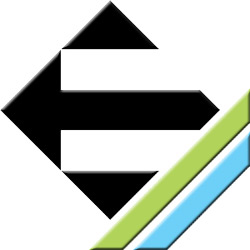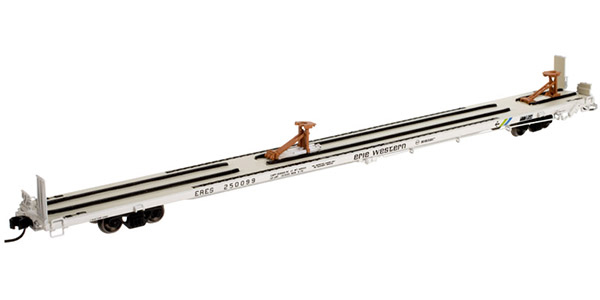Model Information: Manufactured in two (mid and end) and three hitch versions, based upon ACF plans for the 1973 models, the Atlas replicas are packaged with two different styles of hitch, container pedestals, and the correct jack pads for that year.
The manufacturer's recommended minimum operating radius for these cars is thirteen inches.
Prototype Information: Introduced in the late 1960s, the ACF 89 foot 4 inch flatcars were designed to meet the growing need for versatile intermodal rolling-stock.
Used by Trailer Train and other North American railroads, the cars were designed to carry a pair of trailers or containers, or a combination of one of each.
Many of the 1960s and 1970s era ACF flatcars were modified in the late 1980s to accept longer trailer lengths, with the majority of those remaining in service today modified to accommodate three parcel pup trailers.
The manufacturer's recommended minimum operating radius for these cars is thirteen inches.
Prototype Information: Introduced in the late 1960s, the ACF 89 foot 4 inch flatcars were designed to meet the growing need for versatile intermodal rolling-stock.
Used by Trailer Train and other North American railroads, the cars were designed to carry a pair of trailers or containers, or a combination of one of each.
Many of the 1960s and 1970s era ACF flatcars were modified in the late 1980s to accept longer trailer lengths, with the majority of those remaining in service today modified to accommodate three parcel pup trailers.
Prototype History: A flatcar (US) (also flat car (US) or flat wagon (UIC)) is a piece of railroad (US) or railway (non-US) rolling stock that consists of an open, flat deck mounted on a pair of trucks (US) or bogies (UK), one at each end containing four or six wheels. Occasionally, flat cars designed to carry extra heavy or extra large loads are mounted on a pair (or rarely, more) of bogeys under each end . The deck of the car can be wood or steel, and the sides of the deck can include pockets for stakes or tie-down points to secure loads. Flatcars designed for carrying machinery have sliding chain assemblies recessed in the deck.
Flatcars are used for loads that are too large or cumbersome to load in enclosed cars such as boxcars. They are also often used to transport intermodal containers (shipping containers) or trailers as part of intermodal freight transport shipping.
COFC (Container On Flat Car) cars are typically 89' long and carry four 20' intermodal containers or two 40'/45' shipping containers (the two 45' containers are carryable due to the fact that the car is actually 92' long, over the strike plates). With the rise of intermodal freight transport-specific well cars that allow double stacking, and given the age of most of these flats, numbers will decline over the next several years
From Wikipedia
Flatcars are used for loads that are too large or cumbersome to load in enclosed cars such as boxcars. They are also often used to transport intermodal containers (shipping containers) or trailers as part of intermodal freight transport shipping.
COFC (Container On Flat Car) cars are typically 89' long and carry four 20' intermodal containers or two 40'/45' shipping containers (the two 45' containers are carryable due to the fact that the car is actually 92' long, over the strike plates). With the rise of intermodal freight transport-specific well cars that allow double stacking, and given the age of most of these flats, numbers will decline over the next several years
From Wikipedia
Road Name History:  In the run up to the creation of Conrail in 1976, planners were free to leave duplicate routes out of the new system at which point local officials could make their own arrangements if they wished to preserve service. The Erie Lackawanna mainline west of Kenton, Ohio and running all the way to Chicago was left off the Conrail system. Conrail continued to run local service on the route with financial help from the state of Indiana until a local operator could be found.
In the run up to the creation of Conrail in 1976, planners were free to leave duplicate routes out of the new system at which point local officials could make their own arrangements if they wished to preserve service. The Erie Lackawanna mainline west of Kenton, Ohio and running all the way to Chicago was left off the Conrail system. Conrail continued to run local service on the route with financial help from the state of Indiana until a local operator could be found.
In 1977, the Erie Western launched operations from the Indiana-Ohio state line west to Hammond, Indiana not too far from Chicago. They also got a branch linking Decatur and Portland, Indiana. Trackage rights on the Chicago & Western Indiana got Erie Western trains from Hammond to Chicago. Total mileage was 185.
The Erie Western had enough traffic to keep 7 locomotives busy. That’s not a good sign since a healthy traffic level for a 185 mile line should require more than twice that many. Three former Long Island Rail Road hi hood C420’s (which never made it out of LIRR blue and yellow paint) were joined by four RS-3’s which were all painted in Erie Western white with blue and green stripes. All units were setup with the long hood as the front.
Erie Western also acquired a number of freight cars many of which were also white with blue and green stripes. These included 3-bay covered hoppers, 89’ flush deck flats for TOFC service and some 50’ boxcars.
Alas, the Conrail planners were right and the Erie Western ran out of money and shutdown in the summer of 1979. Another carrier, the Chicago & Indiana tried to run the line but shut down just 6 months later. Most of the route has been abandoned

In 1977, the Erie Western launched operations from the Indiana-Ohio state line west to Hammond, Indiana not too far from Chicago. They also got a branch linking Decatur and Portland, Indiana. Trackage rights on the Chicago & Western Indiana got Erie Western trains from Hammond to Chicago. Total mileage was 185.
The Erie Western had enough traffic to keep 7 locomotives busy. That’s not a good sign since a healthy traffic level for a 185 mile line should require more than twice that many. Three former Long Island Rail Road hi hood C420’s (which never made it out of LIRR blue and yellow paint) were joined by four RS-3’s which were all painted in Erie Western white with blue and green stripes. All units were setup with the long hood as the front.
Erie Western also acquired a number of freight cars many of which were also white with blue and green stripes. These included 3-bay covered hoppers, 89’ flush deck flats for TOFC service and some 50’ boxcars.
Alas, the Conrail planners were right and the Erie Western ran out of money and shutdown in the summer of 1979. Another carrier, the Chicago & Indiana tried to run the line but shut down just 6 months later. Most of the route has been abandoned
Brand/Importer Information: In 1924 Stephan Schaffan, Sr. founded the Atlas Tool Company in Newark, New Jersey. In 1933 his son, Stephan Schaffan, Jr., came to work for his father at the age of sixteen. Steve Jr. built model airplanes as a hobby and frequented a local hobby shop. Being an enterprising young man, he would often ask the owner if there was anything he could do to earn some extra spending money. Tired of listening to his requests, the hobby-store owner threw some model railroad track parts his way and said, "Here, see if you can improve on this".
In those days, railroad modelers had to assemble and build everything from scratch. Steve Jr. created a "switch kit" which sold so well, that the entire family worked on them in the basement at night, while doing business as usual in the machine shop during the day.
Subsequently, Steve Jr. engineered the stapling of rail to fiber track, along with inventing the first practical rail joiner and pre-assembled turnouts and flexible track. All of these products, and more, helped to popularize model railroading and assisted in the creation of a mass-market hobby. The budding entrepreneur quickly outgrew the limitations of a basement and small garage operation. Realizing they could actually make a living selling track and related products, Steve and his father had the first factory built in Hillside, New Jersey at 413 Florence Avenue in 1947. On September 30, 1949, the Atlas Tool Company was officially incorporated as a New Jersey company.
In 1985, Steve was honored posthumously for his inventions by the Model Railroad Industry Association and was inducted into the Model Railroad Industry Hall of Fame in Baltimore, Maryland. In addition, Steve was nominated and entered into the National Model Railroad Association Pioneers of Model Railroading in 1995.
In the early 1990s, the Atlas Tool Company changed its name to Atlas Model Railroad Company, Inc.
In those days, railroad modelers had to assemble and build everything from scratch. Steve Jr. created a "switch kit" which sold so well, that the entire family worked on them in the basement at night, while doing business as usual in the machine shop during the day.
Subsequently, Steve Jr. engineered the stapling of rail to fiber track, along with inventing the first practical rail joiner and pre-assembled turnouts and flexible track. All of these products, and more, helped to popularize model railroading and assisted in the creation of a mass-market hobby. The budding entrepreneur quickly outgrew the limitations of a basement and small garage operation. Realizing they could actually make a living selling track and related products, Steve and his father had the first factory built in Hillside, New Jersey at 413 Florence Avenue in 1947. On September 30, 1949, the Atlas Tool Company was officially incorporated as a New Jersey company.
In 1985, Steve was honored posthumously for his inventions by the Model Railroad Industry Association and was inducted into the Model Railroad Industry Hall of Fame in Baltimore, Maryland. In addition, Steve was nominated and entered into the National Model Railroad Association Pioneers of Model Railroading in 1995.
In the early 1990s, the Atlas Tool Company changed its name to Atlas Model Railroad Company, Inc.
Item created by: nscalemodeler160 on 2016-08-17 09:28:30. Last edited by gdm on 2018-09-13 23:35:11
If you see errors or missing data in this entry, please feel free to log in and edit it. Anyone with a Gmail account can log in instantly.
If you see errors or missing data in this entry, please feel free to log in and edit it. Anyone with a Gmail account can log in instantly.










